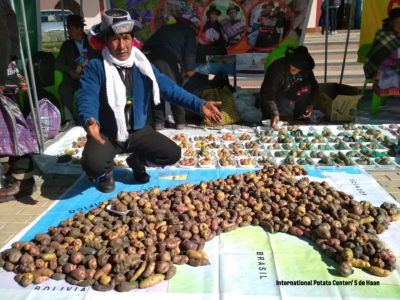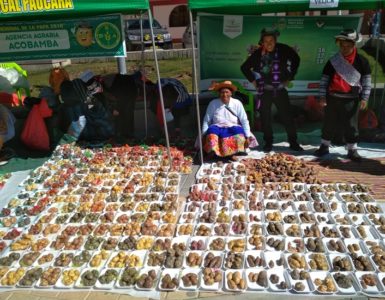 Nine staple crops account for more than 66 percent of all crop production in the world. Research and innovation in these crops have enabled the development of higher yielding varieties that use less land and water and are resistant to pests and drought.
Nine staple crops account for more than 66 percent of all crop production in the world. Research and innovation in these crops have enabled the development of higher yielding varieties that use less land and water and are resistant to pests and drought.
But along the way, the agrobiodiversity within these crops has declined dramatically. As the challenges facing the world’s farmers increase in scope and complexity, the genetic material and knowledge contained in these forgotten varieties will be critical to ensuring the quantity, quality, and stability of food production. While 75% of plant biodiversity has been lost since the early 20th century, the agrobiodiversity within the nine principal species offer important income and nutrition opportunities to small-scale farmers.
Reducing Agrobiodiversity Loss in Peru
Custodian farmers have a special ability and passion for managing diversity in the Andes. Of the more than 3,000 unique potato landraces in Peru, they each grow up to 400, often inherited from their parents or grandparents and further enriched through a process of seed exchange and local selection.
In the Andean region, the cradle of potato diversity, the natural forces driving this Darwinian-type “survival of the fittest” have given birth to vibrant evolutionary processes. Biotic stresses — such as disease and pests — coevolved with a reservoir of potato agrobiodiversity in ever-changing environments. These process have continuously tested the resilience of local genepools.
Traditional knowledge and presence of the potato’s wild relatives has turned the custodians’ fields into “living laboratories for selection” unintentionally exposed to the forces of a changing climate. While most wild relatives produce tiny, inedible tubers, their genetic diversity holds opportunities for breeding more resilient potatoes. This diversity protects the overall productivity and efficiency of our food systems — not necessarily in maximum yield, but rather in yield stability throughout the seasons in scattered fields containing a mix of landraces.
“Some of our varieties are doing well, while the yields of others are slowly diminishing in response to climate change,” said Francisco Salvatierra, a custodian from Peru’s central highland with over five decades of experience.
“The varieties we farmers share with each other have added a greater degree of adaptability into the mix,” Salvatierra mused, as if thinking of specific farming plots with which he was clearly familiar.
This dynamic, adaptive, and evolutionary process lies at the heart of age-old strategies employed by farmers in skillfully adapting to evolving circumstances, be they changing market conditions, pests, or new technologies. Until recently, the vital role played by custodian farmers has been largely ignored by the outside world.
Public and Private Sector Initiatives Support Custodian Farmers’ Success
In 2014, a group of custodians from 50 Andean communities established the Asociación de Guardianes de Papa Native del Centro de Peru (AGUAPAN) to facilitate the exchange of good practices between custodians and help ensure local farmers benefit from the genetic diversity in their communities. AGUAPAN is committed to helping shape international commitments undertaken by Peru’s government to ensure local communities benefit from the presence of diversity in their midst.

And through private sector initiatives, such as the one funded by international potato breeding companies, including HZPC and AGRICO, resources have been devoted to providing direct incentives to small-scale farmers to help manage their agrobiodiversity through a process of ongoing adaptive landrace preservation. Farmers can dedicate time to adaptive landrace preservation in exchange for financial support which helps pay for education and health services for their families and the farm input to grow potatoes.
With technical support from the International Potato Center (CIP), the local NGO Grupo Yanapai, Peru’s Instituto Nacional de Innovación Agraria and the Sociedad Peruana de Derecho Ambiental, the initiative has broadened traditional indicators of yield to include stability (output over time), adaptability (output under stress) and quality (micronutrients per unit of production).
And through private sector initiatives, management of potato landraces by AGUAPAN has given real substance to international and regional commitments to sharing the benefits of genetic plant diversity by local communities. For CIP, this experience is helping scientists and development staff improve their understanding of how Peru’s example can be best applied elsewhere on an even larger scale.
By Stef de Haan, agri-food systems scientist, International Potato Center
Report from 2019 Global Agricultural Productivity (GAP) Report
